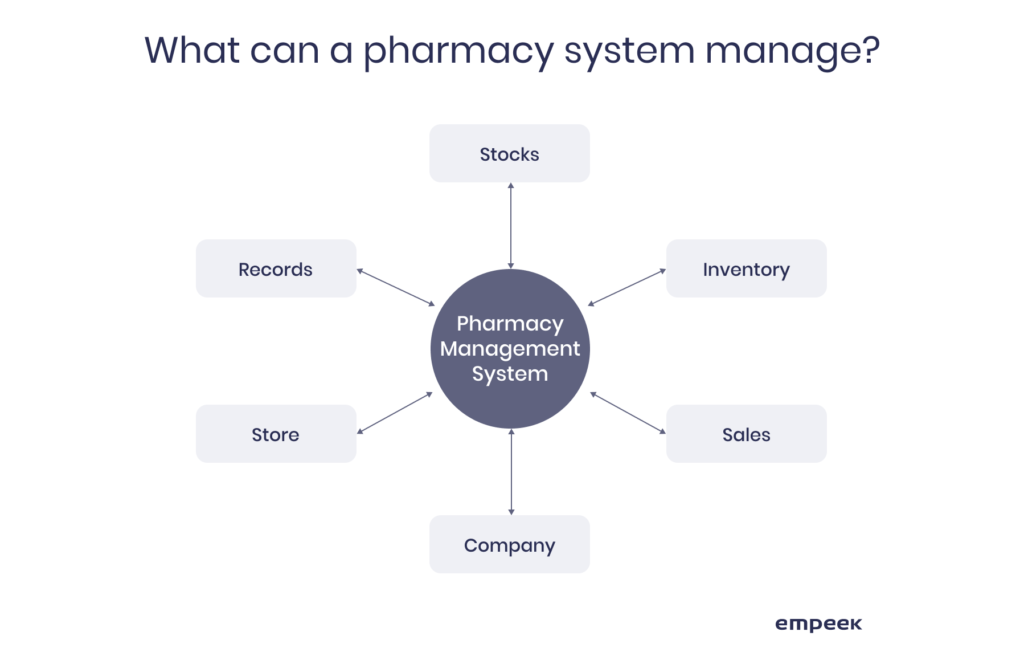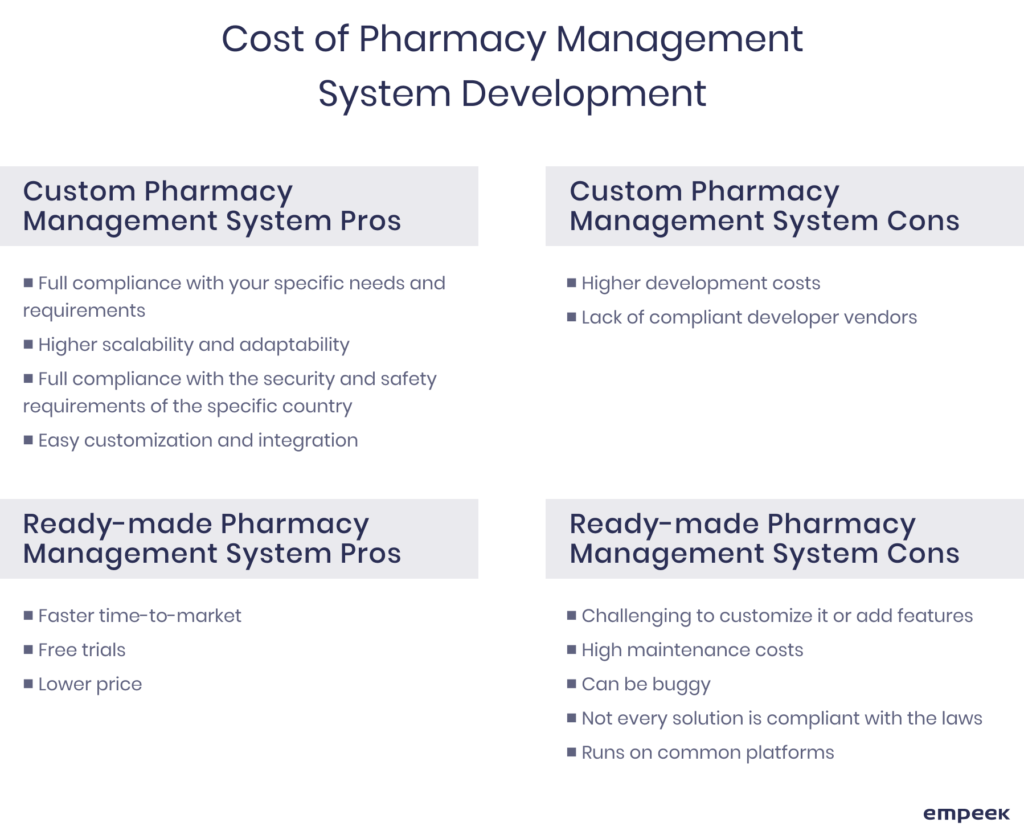With the rapid growth of the healthcare sector and an ever-increasing number of medical providers, there are two quick conclusions we can come to. First, there will be more opportunities to care for one’s health. Second, pharmacy management software development services will become highly popular as pharmacies need an effective management system to help the pharmacists on-site and enable online management. And doing it manually isn’t an option anymore as there is more information to deal with, more clients to serve, and less time to do it effectively. Today, we’ll review a pharmacy management system, how it works, how to develop a pharmacy management software, and what benefits it will have for the pharmacy business.

Pharmacy Management Software Development 101: What It Is and How It Works
Pharmaceutical software solutions is an online usually cloud-based tool that enables swift pharmacy functionality regarding record creation and keeping, stock monitoring, sales, inventory, and company management. With the rapid growth of medical IoT and new technologies, doing things online without compromising their safety and security is a must to keep up with the development of the digitalization of healthcare in general. Add to that pandemic and ‘living online’, and you get the answer to why it’s needed in 2023 and onward.
Luckily, the market shows trends that scream ‘You won’t lose if you direct efforts to pharmacy preceptor development’. Here is the importance of the pharmacy management system in a few stats:
- Global market value of pharmacy management software sector: $16 billion in 2019
- Anticipated value in 2027: $35.3 billion
- Growth rate over 2020-2027: 11.8%
- Dominant market: the USA
- Number of prescriptions dispensed by the end of 2022: 5 billion
Add to that favorable market adoption factors like legal compliance standards, cost-reduction strategies from the major market players, and increased ROI, and you have a clearer picture of the importance of a pharmacy management system and that it will become a must-have tool. But except for making the pharmacists’ routine easier and standing out of the competition regarding the service quality, what are other reasons to develop a software FOR pharmacy management?
Why Bother With Pharmacy Management System Development?
- The purpose of a pharmacy management system is to help detect the expiring/need-to-restock items
- It helps to detect the expiring/need-to-restock items
- It keeps all the notes/drug composition in one place so every pharmacist can use it when needed
- It enables labeling automation and easy scanning (when integrated with barcode scanners)
- It may automatically renew prescription (if integrated with other systems)
- It helps with marketing and understanding the buyer’s behavior
- It makes the ordering/getting prescription easier and faster
- It covers the online pharmacy shopping needs of the clients
- It can be integrated into the existing medical network and facilitates centralized monitoring of performance
Of course, it’s not the complete list of advantages of the pharmacy management system, and since every hospital or pharmacy has its requests and requirements, the full potential will depend on each establishment. Let’s review the common e-prescription software features one needs to pay attention to when developing pharmacy management software.

Must-have Pharmacy Management Software Features
Before creating a pharmacy management software, it’s important to answer a few questions to make sure you’ll receive the enhancement you wanted and needed.
- Should it be autonomous software or do you plan to integrate it into your existing or future network?
- What are the legal requirements of the targeted country concerning processing the protected health information (PHI)?
- Are you going to use it for one store only or will it need to be scalable?
- Do you plan to develop a mobile application for the users that would also be connected with the pharmacy software?
Answering these questions will not only suggest which features of the pharmacy management system should be included but also will help to define the scope of work for the software vendor and estimated cost, which we’ll talk about further. Now, let’s focus on the features and modules that you can stuff the software with.

Easy inventory management
Spending one-fifth of the working day managing the inventory is too much of a luxury for a pharmacist but that’s exactly how much time it takes to do it manually. Having it automated in the pharmacy management software not only will free some hours for the store workers but will safeguard against human-related errors, enable fast audits, and make it easy to track.
Typical features of pharmacy management system to think about:
- Control stock by product and location
- Get stock updates to know when purchasing a particular drug again
- Generate reports to plan re-stocking
- Get notifications when it’s time to order from your suppliers
Prescription handling
Another thing to ease the workflow is to make prescription management fast and error-free. Pharmaceutical software solutions make the preparation, pick-up, and refill process a matter of minutes. The result? Less incoming calls, fewer queues, and more happy customers.
Workflow management
Pharmacists aren’t just the people giving us the prescribed medicine — some of them can prescribe them for us depending on the situation. Moreover, they have to review all the medical conditions, drug information and recommended dosage, compare it with previously prescribed or currently taken medication to avert side effects. And, as a study showed, double-checking the doctor’s prescription is necessary to eliminate the errors when discharging medication. The purpose of developing a pharmacy management system is to make this process faster and safer.
Analytics and reporting
Quality analytics helps the pharmacy to cope with running the business and plan for the future. It shows that some medication is prescribed more often and needs to be supplied respectively, while others show less demand. With a pharmacy management system, you have an opportunity to generate any kind of report within a click. Think of audits or tax filing you need to do regularly and you’ll understand the worth of getting the reports automatically.

Financial management
Billing is another pain point of the pharma business as it involves three parties: consumer, pharmacy, supplier. Automating the billing procedures is a necessity and the business better invest in it to avoid mistakes.
It should take care of:
- Daily transactions
- Supply billing
- Insurance reimbursement
- Delayed payments
Online pharmacy
Another important function in the pharmacy management system is ordering medication online – is what every patient will prefer to do, especially during the time of COVID-19. And it’s possible to do it. E-pharmacy is a great solution to expand the retail business and add value. The website and e-commerce suite aren’t enough since you may work with prescription-only drugs, where you’ll need to have a copy of the original receipt to discharge a medication.

Notifications and alerts
It’s always great to know when to restock or remind the patient to renew a prescription if necessary, and notification and alerts will do it the best. Depending on what you want to be reminded of, you can tailor the pharmacy management software to notify you about the need to restock, check the expiration dates, run security and software checks, detect at-risk patients, and more.
Integration
Development of pharmacy management program may and should include integration option. Why? Because a systemic approach is always better, faster, and easier to track. Consider these options.
- E-prescriptions
- Point-of-sale (POS) terminals
- EHR/ERM
- Interactive voice assistant
These features of the pharmacy management system will allow for seeing a bigger picture, detecting potential incompatibility, evaluating risk/benefits, and providing overall better care.
Additional functionality
Nice-to-haves of the pharmacy management system may include:
- Pill imagine
- E-signature
- Documentation management
- Labeling and barcode scanning
As we’ve covered the features of the system, what are the technologies that can make it happen?
Pharmacy Management System: What Technology Stack to Use?
Having solid experience with pharma app development services, the Empeek team came up with the tech stack which will best fit the pharmacy management system workflow, functionality, scalability-, and safety-wise. When you develop an online pharmacy management system, consider these as your go-to solutions.
- AWS: to ensure safety as it offers security protocols and ciphers
- Docker and Kubernetes: to allow easy scalability
- Microservice architecture and Kafka: to resist performance degradation
- React, Redux, Material-UI: to develop adaptable front-end
- PostgreSQL: to store data
But what if you’re the business that doesn’t want to dive into the nuances of the technologies but wants to get a reliable and safe solution instead? We have the answer.
How to Create a Pharmacy Management System in 6 Steps
- State the business goals. Why do you need pharmacy management software? What is the purpose of the pharmacy management system? What issues do you want to resolve?
- Write out your requirements. This should be about the functionality of the app. Special attention should also be paid to the UX/UI design of the pharmacy management system. What should it do and what should it look like?
- Listen to the users. Interview both pharmacy workers, doctors, and customers about what would they like the system to do.
- Record the insights. Their requests and suggestions should be the focus for development as you make it for them to use.
- Find a vendor. And not just any developer company. They have to understand the compliance policies and laws for creating the solutions that deal with PHI.
- Test with real users. Involve them in the software programs for drug testing to ensure the best UX design of the pharmacy management system.
You would probably like to know how much pharmacy software costs. Well, it depends on a few factors.
How Much Does a Pharmacy Management System Cost?
One of the biggest factors that can affect the development cost is whether it will be a from-scratch solution or ready-made. Each of them has its pros and cons, and the choice will depend on what you expect from the system. See the comparison table.

The final estimate will depend on the features you want in your pharmacy management software, the integration options, users, scalability, and features. Only after answering these questions, a reputable vendor can estimate and provide a free quote for you.
Consider Our Company Your Trusted Partner
Empeek developers know how to create a pharmacy management software as well as what it takes to ensure its safety, compliance, and durability. We have expertise in developing IoT solutions for healthcare that are already used in the USA, Israel, and EU. We also create software for medical devices and integrate it across the existing medical systems. When developing any solution, we build our processes with the legal requirements from the start, which doesn’t only reduce the time-to-market, but also prevents unnecessary spendings. Read more about the services we provide.

Final Thoughts
Working on the ‘how to build a pharmacy management software’ dilemma effectively, requires a solid understanding of the business needs, technology capabilities, and legal regulations of the targeted country. This online tool can cut the hours spent on manual work, enhance the smooth workflow, improve customer satisfaction rate, and reduce human errors. Ready to talk about your project? Contact Empeek today and let’s discuss how we can make it happen!








